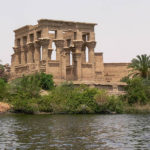Peppered with palm tree plantations and sloping villages of colorful mud-brick houses, Elephantine Island is Aswan’s major tourist attraction.
At its southern end are Aswan Museum and the Ruins of Abu, Aswan’s most ancient settlement, which contains the Old Kingdom Temple of Khnum and the Temple of Satet.
The museum building, in a beautiful late 19th-century villa, is partially open, with a collection of artifacts that span Elephantine Island’s history up to the Roman era.
On the eastern embankment near the ruins and down a flight of steps is Aswan’s Nilometer. Ancient Egyptians measured the Nile’s rise and fall with these stone-hewn wells, allowing them to estimate the height of the annual flood and thus predict the success of their harvest.
Once you’ve finished exploring the ruins, head north into the island to wander the backstreets of the villages of Koti and Siou, where the houses are painted with vibrantly colored designs. Sheep graze and chickens peck in the narrow alleyways, and farmers till their gardens as they have done for centuries.
From the boat landing on the western side of the island in Siou, you can catch a rowboat to Kitchener’s Island. Now officially known as Aswan Botanical Gardens (though no one actually calls it that), this island was once the property of Lord Kitchener who transformed it into a verdant garden of exotic plants from Asia and Africa.
There are frequent local ferries from the boat landing in downtown Aswan to Elephantine, or you can also hire a felucca to sail you around the island



